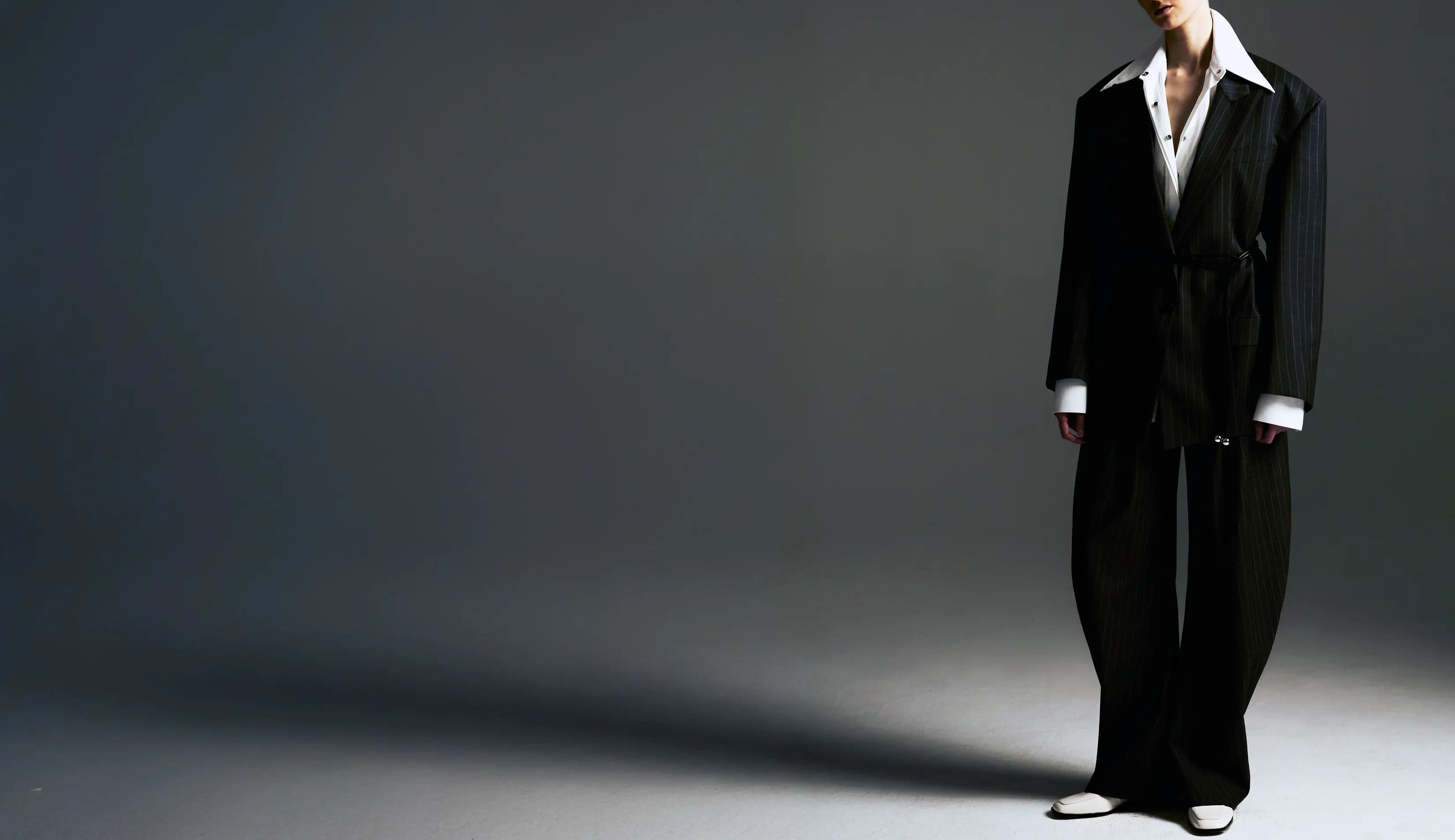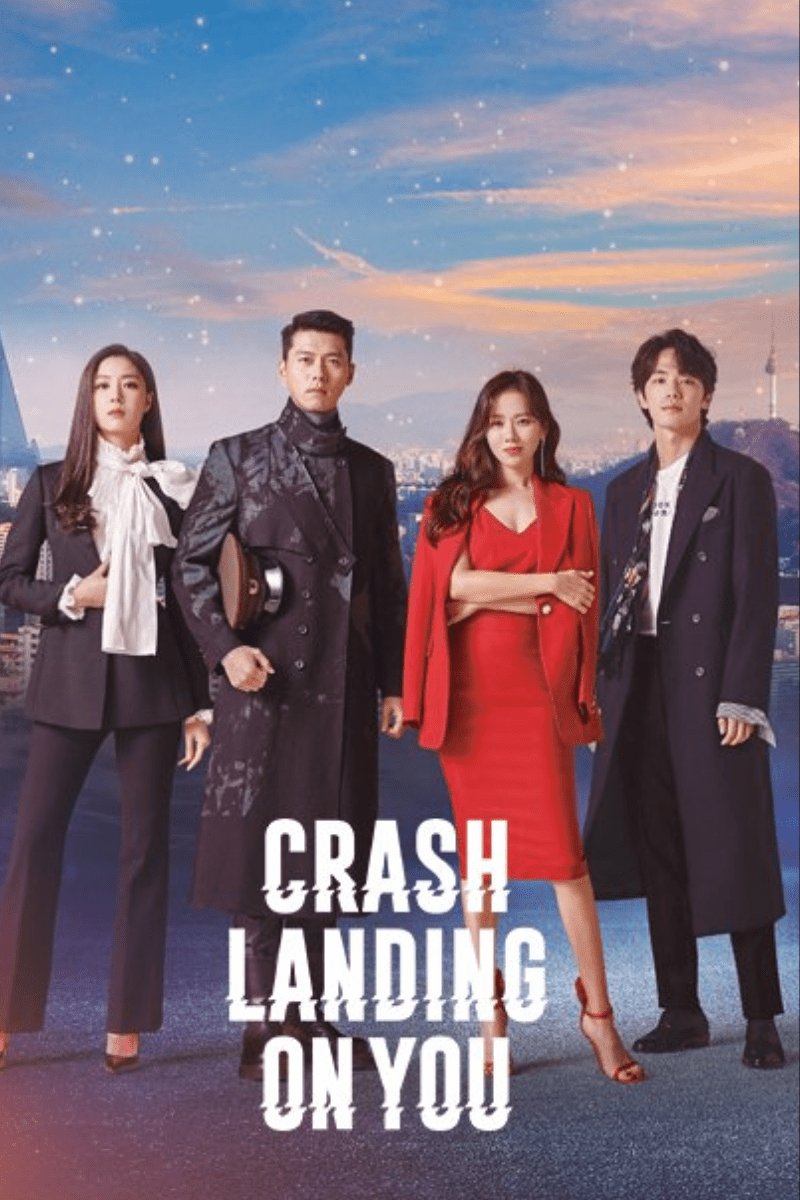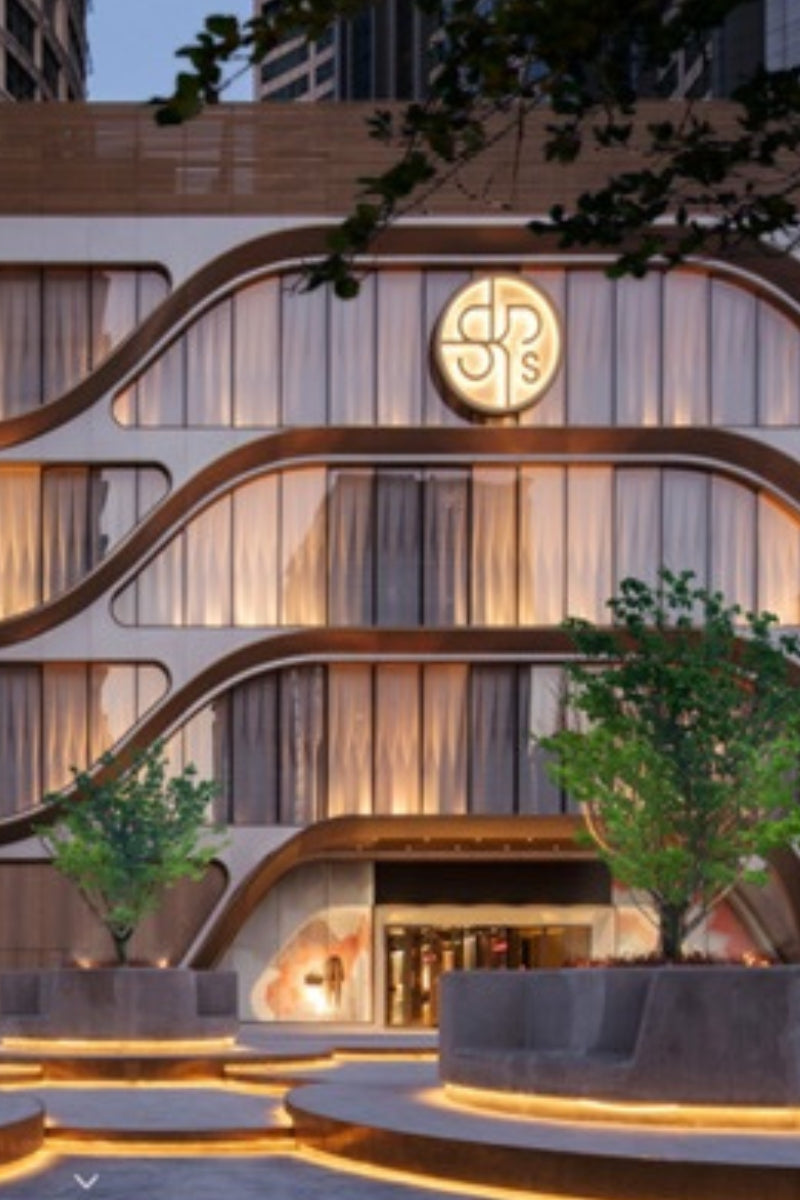Collective Precision: Redefining Formal Coordination
The technical challenges of creating cohesive formal wear for multiple individuals require construction expertise that extends past traditional bespoke tailoring. Each BTS member's tuxedo must complement the others while accommodating individual body proportions, movement requirements, and personal preferences—a tailoring problem that resembles orchestrating a chamber ensemble where each instrument must contribute to harmonic unity while maintaining distinct tonal characteristics.
Traditional formal wear coordination typically involves selecting similar styles from established options—matching tuxedo rentals with minor variations in fit and finishing. K-Pop's approach demands custom construction that creates visual consistency through technical execution rather than identical styling. This requires understanding how fabric weight, lapel proportions, and silhouette relationships interact across different body types to maintain group coherence under various lighting conditions and photographic angles.
The mathematical precision becomes particularly complex when addressing proportional relationships across multiple wearers. A lapel width that creates optimal visual balance on one person might appear disproportionate on another, requiring custom calculations for each individual while maintaining overall aesthetic consistency. The floating canvas construction must provide uniform structure across different torso shapes, while button placement and waist suppression require adjustment to ensure the group presents unified visual rhythm despite individual anatomical differences.
Color coordination presents additional technical challenges that don't exist in single-garment construction. Black formal wear appears straightforward until examined under performance lighting or photographic conditions, where subtle variations in fabric finish, dye lots, or weave structure become dramatically visible. Creating true color consistency across multiple garments requires sourcing from single fabric lots and implementing identical finishing techniques—a level of coordination that most formal wear providers don't typically manage.
The performance requirements add another layer of complexity. Unlike traditional formal occasions where movement is limited and predictable, K-Pop performance contexts demand formal wear that accommodates choreographed movement, rapid position changes, and extended wear under stage lighting. This necessitates construction techniques that combine formal wear aesthetics with performance wear engineering—reinforced stress points, moisture management considerations, and fabric selections that maintain appearance integrity under extreme conditions.
BTS's Grammy presentation exemplifies successful execution of these technical challenges. The visual consistency of their black tuxedos demonstrates coordination that required extensive planning, custom construction, and sophisticated understanding of how formal elements interact in group presentations. Their unified appearance suggests that formal wear's evolution might prioritize technical coordination expertise over individual customization preferences.
Performance Architecture: When Formal Wear Becomes Functional
The integration of performance requirements into formal wear design creates construction challenges that push traditional tailoring boundaries while maintaining ceremonial appropriateness. K-Pop's approach to formal attire must simultaneously address visual presentation standards and practical performance demands—a technical problem that resembles designing evening wear for professional athletes.
Stage lighting dramatically affects fabric appearance and silhouette perception in ways that don't typically influence formal wear selection. Fabric choices that appear sophisticated under natural or indoor lighting might create unexpected visual effects under performance conditions. The directional nature of stage lighting can emphasize construction seaming, alter color perception, or create shadow patterns that interfere with intended silhouette presentation. This consideration requires fabric selection and construction techniques that account for how materials will respond to intense, colored, or moving light sources.
The armscye construction becomes particularly critical in performance contexts. Traditional formal wear prioritizes static presentation—how the garment appears when the wearer is standing or moving minimally. Performance requirements demand shoulder construction that maintains formal appearance while accommodating full range of motion, including overhead arm movement, lateral stretching, and rapid directional changes. This typically requires enlarging the armhole circumference and adjusting the sleeve attachment to prevent restriction, while maintaining the structured shoulder line that defines formal silhouette.
Moisture management considerations don't typically influence formal wear construction, but performance contexts make this a primary technical concern. Traditional formal fabrics and construction methods often prioritize appearance over breathability, creating garments that become uncomfortable or visually compromised under performance conditions. Addressing this challenge requires fabric selections that balance formal appearance with technical performance properties, often involving fabric blends or treatments that aren't standard in conventional formal wear construction.
The internal construction must also accommodate rapid costume changes or modifications that might be required during extended performance schedules. Traditional formal wear construction prioritizes permanence and durability over accessibility—buttons, closures, and internal elements are typically designed for careful, occasional use rather than frequent manipulation. Performance contexts might require construction modifications that allow rapid adjustment or replacement of specific elements without compromising overall garment integrity.
BTS's formal wear demonstrates successful integration of these performance requirements without sacrificing ceremonial appropriateness. Their Grammy presentation suggests that formal wear evolution might incorporate technical innovations developed for entertainment applications, creating garments that perform better under demanding conditions while maintaining traditional aesthetic standards.
Cultural Translation: Eastern Formality Principles in Western Contexts
The intersection of Korean formal wear traditions with Western ceremonial expectations creates fascinating hybrid approaches that challenge fundamental assumptions about appropriate formal presentation. Korean culture's relationship with formal dress differs significantly from Western conventions, particularly in areas of color significance, proportional preferences, and the balance between individual expression and group harmony.
Korean formal traditions often emphasize collective presentation over individual distinction, a cultural value that conflicts with Western formal wear's focus on personal expression within accepted parameters. This cultural difference becomes visible in how K-Pop groups approach coordinated formal presentation—their unified aesthetic serves cultural values that prioritize group success and harmony over individual standout moments. This philosophical difference suggests alternative approaches to formal occasions that might resonate with contemporary values emphasizing collaboration and shared experience.
The proportional preferences in Korean formal wear often favor different silhouette relationships than traditional Western formal standards. Korean aesthetic traditions might prioritize longer jacket lengths, different button stances, or alternative lapel proportions that create visual effects more aligned with Korean beauty standards. When these preferences encounter Western formal contexts, the result often involves hybrid construction that balances cultural authenticity with contextual appropriateness.
Color symbolism also operates differently across cultural frameworks. Colors that carry formal significance in Korean contexts might not translate directly to Western formal wear expectations, requiring thoughtful navigation of cultural meanings and contextual appropriateness. BTS's choice of coordinated black tuxedos represents a culturally neutral selection that honors both traditions while avoiding potential cultural misinterpretation.
The fit philosophy differs significantly between cultural approaches to formal wear. Western formal traditions often emphasize precise body-conscious fitting that demonstrates tailoring expertise through obvious customization. Korean approaches might prioritize different fitting relationships that serve alternative aesthetic goals or comfort preferences. Successfully integrating these different philosophies requires understanding both cultural frameworks and creating construction solutions that honor multiple aesthetic traditions.
The styling approach also reflects cultural differences in formal presentation. Western formal wear styling often emphasizes individual accessories and personal touches that distinguish the wearer within accepted parameters. Korean formal approaches might prioritize coordination and harmony over individual distinction, creating styling solutions that serve group presentation goals rather than individual expression priorities.
Technical Innovation Through Cultural Fusion
The synthesis of Korean design philosophy with Western formal wear construction standards generates technical innovations that expand the possibilities of ceremonial dress. These innovations often emerge from the necessity of solving problems that don't exist when working within single cultural frameworks, creating solutions that benefit both traditional approaches.
One significant innovation involves modular construction techniques that allow formal wear to serve multiple presentation contexts. Some K-Pop formal garments incorporate removable or adjustable elements that permit the same garment to function in different cultural contexts or presentation requirements. This approach requires advanced pattern-making skills and construction techniques that prioritize adaptability without compromising formal appropriateness.
The integration of performance textiles into formal wear construction represents another area of innovation. Traditional formal fabrics prioritize appearance and durability but often lack technical properties that enhance wearer comfort or garment performance. The incorporation of moisture-wicking fibers, stretch elements, or temperature-regulating materials into formal constructions requires understanding both traditional tailoring principles and textile technology applications.
Sizing and fitting innovations also emerge from cross-cultural applications. Different cultural populations might have distinct average body proportions or fitting preferences that require adjustment to traditional formal wear sizing standards. Addressing these differences has generated new approaches to pattern development and fitting that accommodate broader demographic ranges while maintaining construction quality.
The documentation and communication innovations required for cross-cultural formal wear projects also drive technical advancement. Creating formal wear that meets cultural expectations from multiple traditions requires communication methods and documentation standards that bridge different cultural approaches to craftsmanship and quality assessment.
Color matching and coordination techniques also advance through cross-cultural applications. Different cultural contexts might have varying standards for color accuracy or coordination precision, requiring technical approaches that meet the highest standards from multiple traditions. This often involves advanced dyeing, finishing, or coordination techniques that exceed conventional formal wear requirements.
The Economics of Coordinated Formality
The financial implications of creating coordinated formal wear for multiple individuals extend past simple multiplication of individual garment costs. The technical complexity required for successful group coordination often creates cost structures that reflect specialized expertise and coordination challenges rather than straightforward material and labor calculations.
Pattern development for coordinated formal wear requires extensive planning and communication that doesn't exist in individual garment projects. Creating visual consistency across multiple body types and individual preferences demands pattern modifications and fitting approaches that require significantly more development time than traditional formal wear projects. This coordination complexity must be factored into pricing structures that reflect the specialized planning and communication required.
The fitting process becomes exponentially more complex when addressing multiple individuals with coordination requirements. Traditional formal wear fittings focus on achieving optimal fit and appearance for individual wearers. Coordinated projects must balance individual fit optimization with group presentation goals, often requiring compromise decisions that serve overall aesthetic objectives while maintaining individual comfort and appearance standards.
Quality control and consistency standards also increase project costs. Individual formal wear projects can accommodate minor variations in construction details or finishing quality without affecting overall success. Coordinated projects require consistency standards that ensure visual harmony across multiple garments, often requiring additional quality control processes and potential reconstruction to meet coordination requirements.
The timeline coordination challenges also impact project costs. Individual formal wear projects can accommodate flexible scheduling and individual availability. Group projects require synchronized scheduling and delivery that often involves compressed timelines or coordination challenges that affect overall project efficiency and cost structure.
Specialized expertise requirements for successful group coordination often command premium pricing. The technical knowledge needed to create visually consistent formal wear across multiple individuals represents advanced skills that merit compensation reflecting the specialized planning, communication, and execution expertise required.
Future Trajectories: Where Formal Coordination Evolves
The technical innovations emerging from K-Pop's approach to formal wear suggest several evolutionary directions that could influence broader formal wear construction approaches. These developments represent fundamental shifts in how formal occasions are conceptualized, planned, and executed rather than simply aesthetic trend variations.
Sustainability considerations increasingly influence coordinated formal wear approaches. The traditional model of individual formal wear ownership creates environmental challenges through limited usage and storage requirements. Coordinated approaches that emphasize rental, sharing, or modular construction could reduce environmental impact while maintaining formal presentation standards.
Technology integration will likely accelerate in formal wear applications, with smart fabrics and responsive elements becoming more sophisticated and accessible. The performance requirements that drive K-Pop formal innovations create testing opportunities for emerging technologies that might eventually find broader formal wear applications.
The democratization of coordination expertise through digital tools and communication platforms could make sophisticated formal coordination more accessible to smaller events and individual consumers. This trend might challenge traditional formal wear industry hierarchies while expanding access to advanced coordination techniques.
Cultural fusion in formal wear approaches will likely continue expanding, with innovations from entertainment applications influencing broader formal wear construction and styling approaches. This cross-pollination creates opportunities for technical advancement that draws from diverse cultural traditions and application contexts.
The relationship between formal wear and performance will probably deepen, with construction techniques developed for entertainment applications finding utility in other formal contexts that involve presentation, photography, or extended wear requirements. The performance demands that drive K-Pop formal innovations address challenges that exist across multiple formal occasion categories.
Collective Authenticity: Groups as Individual Expression
The philosophical implications of coordinated formal presentation extend past technical construction challenges to address fundamental questions about authenticity, individual expression, and group belonging in contemporary formal contexts. BTS's unified Grammy presentation suggests alternative approaches to formal occasions that might resonate with cultural values emphasizing collaboration and shared experience over individual distinction.
Traditional Western formal wear philosophy emphasizes individual expression within accepted parameters—personal touches and customization choices that distinguish the wearer while maintaining appropriate formality. This approach serves cultural values that prioritize individual achievement and personal distinction. Contemporary culture increasingly values collaborative success and group harmony, suggesting that formal wear traditions might evolve to serve these changing priorities.
The authenticity question becomes particularly complex in coordinated contexts. Individual formal wear allows personal choice and expression that can feel authentic to the wearer's preferences and personality. Coordinated formal wear requires compromise and collaboration that might feel less individually authentic but creates authentic group expression that serves collective goals and shared aesthetic vision.
The social dynamics of coordinated formal presentation also differ significantly from individual approaches. Group coordination requires communication, planning, and compromise that creates shared investment in the overall presentation outcome. This collaborative process might create more meaningful formal experiences than individual selection and customization approaches.
The photography and documentation benefits of coordinated formal presentation also serve contemporary formal occasion priorities. Social media and event documentation often emphasize group presentation and visual harmony over individual distinction. Coordinated formal approaches might serve these contemporary documentation expectations more effectively than traditional individual approaches.
The cost and sustainability benefits of coordinated approaches also align with contemporary values emphasizing resource efficiency and environmental responsibility. Coordinated projects might achieve better cost efficiency and environmental impact than individual formal wear approaches, particularly for events involving multiple participants.
Design Sessions: Collaborative Formal Construction
The process of creating coordinated formal wear requires design approaches that differ fundamentally from traditional individual tailoring consultations. Successful group coordination demands communication methods, decision-making processes, and technical approaches that serve collective goals while addressing individual needs and preferences.
The initial planning phase becomes critical in coordinated projects. Unlike individual formal wear consultations that can accommodate changing preferences and evolving requirements, group projects require early consensus on aesthetic direction, quality standards, and coordination priorities. This planning phase often determines project success more significantly than individual construction expertise.
Communication management becomes a specialized skill in coordinated formal wear projects. Managing multiple individual preferences, body types, timeline requirements, and budget considerations requires coordination expertise that extends past traditional tailoring skills. Successful coordination often depends on project management and communication skills as much as technical construction expertise.
The fitting process requires modified approaches that balance individual optimization with group coordination requirements. Traditional fitting focuses on achieving optimal individual fit and appearance. Coordinated fitting must consider how individual adjustments affect overall group presentation, often requiring compromise decisions that serve collective aesthetic goals.
Quality control processes also require modification for coordinated projects. Individual formal wear projects can accommodate minor variations in construction details without affecting overall success. Group coordination requires consistency standards that ensure visual harmony, often demanding additional quality control processes and potential reconstruction to meet coordination requirements.
The delivery and final presentation coordination also requires specialized management. Individual formal wear projects conclude with individual delivery and fitting verification. Group projects require coordinated delivery, final fitting verification, and presentation coordination that ensures successful collective presentation at the actual formal occasion.
Conclusion: Performance as Authenticity Framework
BTS's coordinated Grammy presentation demonstrates how performance-driven approaches to formal wear might offer solutions to contemporary questions about authenticity, coordination, and the relationship between individual expression and group belonging. Their unified aesthetic suggests that formal wear's evolution might prioritize collective vision and shared experience over traditional individual customization approaches.
The technical innovations emerging from K-Pop's formal wear applications offer valuable insights for formal occasions that extend past entertainment contexts. The coordination expertise required for successful group presentation, the performance engineering needed to support extended formal wear, and the cultural intelligence necessary to navigate multiple aesthetic traditions all contribute to expanded understanding of what sophisticated formal wear can accomplish.
The future of formal occasions will likely incorporate lessons learned from entertainment industry innovations—not necessarily adopting performance aesthetics, but understanding advanced approaches to coordination, construction, and presentation that serve contemporary values and practical requirements. The techniques developed for entertainment applications might inform wedding planning, corporate events, or other formal occasions that prioritize group presentation and collaborative success.
As formal wear continues evolving in response to changing cultural values and practical requirements, the technical foundations established by K-Pop's coordinated approaches provide valuable precedents for addressing formal occasions that emphasize collaboration, sustainability, and authentic group expression. The precision required for successful coordination suggests that the most enduring formal wear innovations might be those that solve practical problems while serving contemporary cultural values about authenticity and belonging.




